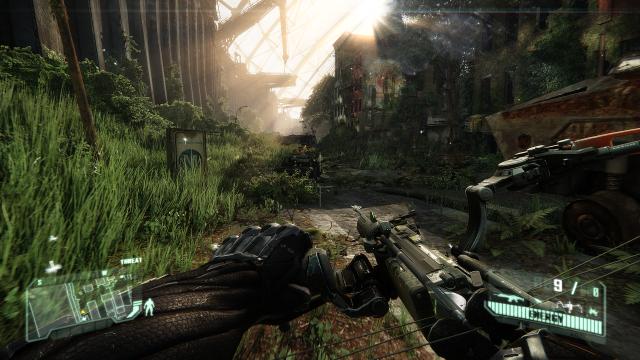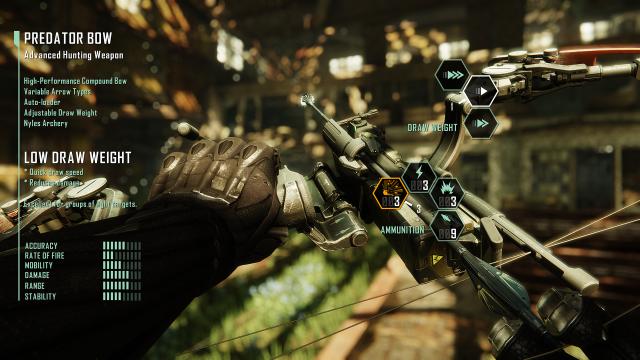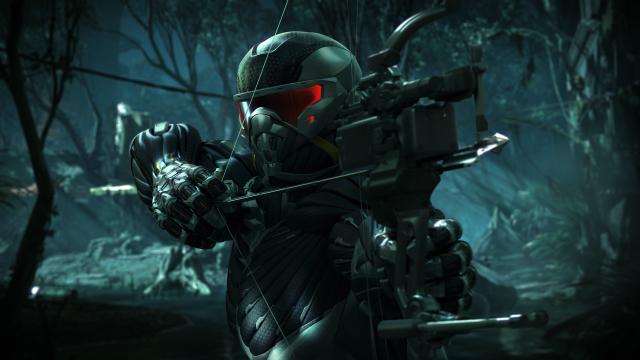 Game: Crysis 3
Game: Crysis 3
Developer: Crytek
Publisher: EA
Available on: Xbox 360, PlayStation 3, Windows PC
Reviewed on: Xbox 360
2011’s Crysis 2 was the perfect example of a game that had all the right ingredients but didn’t quite manage to mix them together into the perfect soup. Graphically, it was one of the most beautiful titles released in the current console generation, boasting a highly detailed world that did a great job of convincing the player that it was massive and open when, in fact, each area was relatively small compared to other sci-fi shooters at the time. The combat capabilities of the iconic Nanosuit rendered the game just that little bit too easy, as you strode through the alien-infested streets of New York as suited-up super-soldier, Alcatraz. You were presented with potential sandboxes and a set of tools with which to assault them, but the Nanosuit made Alcatraz so overpowered against puny humans that by the latter half of the game you were almost hoping something would put a kibosh on your carefully orchestrated plans just to make you work that little bit harder.
It’s now been almost three years, and developers Crytek have taken the core concepts of the Crysis series back to the drawing board, hoping to keep the positive elements intact and weed out the bad, essentially polishing the experience to its ultimate shine. But have they succeeded in correcting the perceived mistakes of Crysis 2? Or is Crysis 3 simply more of the same but with shinier graphics?
STORY: Crysis 3 picks up roughly 20 years after the last game ended, and begins with “skinned” former Nanosuit soldier Michael “Psycho” Sykes rescuing a comatose Prophet from a similar fate (that is, being cut out of the Nanosuit whilst fully conscious). Although it’s not blatantly explained, it becomes clear that Alcatraz from the last game is now completely gone, absorbed by the suit at a genetic level to become Lawrence “Prophet” Barnes once again. Following the chronology of the series is surprisingly headache-inducing, but suffice to say that Prophet means serious business when it comes to warfare.
Psycho explains that, while Prophet was sleeping, shady global organisation CELL took credit for stopping the invasion by the alien Ceph, and have seized control of all the alien technology to become the largest superpower in the world. New York is ground zero for CELL’s strike for world domination, and Prophet wakes to find it encased within the Liberty Dome, a huge energy bubble created by CELL that keeps the city separated from the rest of the world. Inside the Dome, New York has become a literal urban jungle, overgrown with foliage and populated by wild animals. Divided into seven zone, nicknamed the “Seven Wonders”, the Liberty Dome is where the majority of Crysis 3’s story takes place.
As a narrative, it’s enough to keep your attention even if it’s nothing spectacular. The best addition to the plot is the return of Psycho as a mostly-permanent sidekick, whose presence allows him to spit out exposition in his foul-mouthed, cockney drawl and keep you up-to-date. More crucial than this, however, is that his existence allows us to see more of Prophet’s actual personality, as our protagonist’s calmer demeanor plays off against Psycho’s understandable rancour. The plot may be thin but it’s never spoon-fed, and even with Psycho’s regular chit-chat and unhinged outbursts, there are enough surprises in the narrative to both please and surprise series fans.
GRAPHICS: It’s ironic that we never really see what a console can do until we approach the end of its current generation. Graphically speaking, Crysis 3 gets more out of the 360 than any game before it – running on a high-end PC with all the setting dialled right up, the latest installment in this series still sets the benchmark for visual fidelity and presents the CryEngine 3 as arguably the most accomplished current-gen engine in service today. Even on consoles the game stuns in HD, and Crytek knew what they were doing setting the opening level outside, at night, in the middle of a rainstorm. Dynamic lighting, shadows, weather effects, and attention to detail create a gorgeous, breathtaking game-world right from the off – an achievement compounded when you venture outside into the foliage-wrapped, sun-dappled wasteland that New York has become.

At times, the high level of detail in the world can almost be a hindrance as it becomes difficult to pick off targets at a distance because the environment is just so busy, but everything is so slick and polished that you won’t care. With pin-sharp visuals like this you’d expect some texture pop-in, screen-tear or even a touch of lag, but there is none. Crysis 3 remains smooth and seamless at all times and ensconces you in its dazzling world. The character models are excellent, too, with brilliant, precise lip-synching that keeps you immersed in the cutscenes, and some fantastic facial mapping.
SOUND: Sound direction is an important factor in any game, but in a shooter, well-considered sound design can elevate a mediocre game to the heights of greatness, especially when you’re playing with a decent set of headphones. While explosions and gunfire are par for the course in Crysis 3, there’s an element of unsettling menace when you face off against the Ceph that’s amplified wonderfully by the sounds they make. The gravel-voiced Nanosuit is as reliably gruff as ever, all business and no flirting, while the voice acting is pitch-perfect. Psycho’s lines are particularly well delivered by British actor David Kennedy, whose Statham-esque vehemence is like a malfunctioning cloking device hiding the cracks in a traumatised mind.
GAMEPLAY: Surprisingly, this is once again the area where Crytek come dangerously close to letting the side down. The problems with Crysis 3’s gameplay aren’t caused by any one thing, and they certainly aren’t anything particularly damning, but they are very real. Once again, there’s an issue of balance – between how the game wants you to play, and how the game allows you to play. The Nanosuit is an incredible weapon, and therein lies the crux of the issue: on any setting lower than Veteran, any encounter with the enemy, regardless of their numbers, is barely a bump on the road to victory. The Ceph, returning with a few new types, provide a higher level of challenge later in the game, but taking on CELL troops is often far too easy to deliver the edge-of-your-seat thrills that you might hope for.
A typical scenario will involve entering a new area, either crouching behind a convenient low wall or hunkering down in the long grass, and pressing up on the D-Pad to bring up your suit’s HUD, with which you can mark targets, weapon-drops, ammo resupplies and collectibles. You’ll then select the brand new Predator Bow (one of the most satisfying and effective weapons ever committed to an FPS, by the way), hit RB to engage your suit’s cloak device, and move in on the nearest marked enemy. One arrow later and he’s done (the bow is a one-hit-kill every time on humans) and no one is any the wiser. You’ll then proceed to pick them all off, until your cloak runs out and the slightly inconsistent AI suddenly spots you despite being fifty yards away, at which point they’ll zigzag towards you, using cover effectively in an attempt to bring you down. At this point you tap LB and engage your suit’s armour mode, whip out your machine gun and proceed to wipe out everything else that moves within thirty seconds. As the dust settles, you’ll ask yourself one question: What was the point in all that sneaking I did in the first place?
It was an issue that plagued Crysis 2 and it’s still present now. Crytek give you a playground, give you an objective, and then tool you up with more than you could possibly need to succeed. You are Prophet, a super-soldier badass who can kick cars, hurl explosive barrels, become invisible, throw up a forcefield to soak up bullets, punch walls down, leap the height of a man from a standing position and hit anything you shoot at without a second’s worth of precision-aiming thanks to the magic of auto-targeting. At times I found myself praying something would go wrong just so I’d have to improvise and fight to stay alive, but in 8 encounters out of 10 I emerged with barely a scratch on my visor. There are challenges, but they’re presented by mounted guns, rocket towers, larger one-off enemies, and the Ceph. The majority of the time, you won’t find much to trouble you.
And yet, despite this – or perhaps because of it – Crysis 3 is often incredibly fun. It’s a refreshing change to play as an overpowered beast occasionally, and being able to adapt your suit and your weapons on the fly is now even more intuitive than it was before, and just as cool. Holding down the Back button will bring up the Weapon Customisation screen, which presents elements of your currently equipped gun that can be altered. Pressing Y might, for example, allow you to cycle through barrel extensions, while B might pertain to sights and scopes – it’s such a simple system that in a few brief taps you’ve silenced your weapon and added a reflex sight, and so adapting to survive couldn’t be more straightforward. The suit has a similar mechanism, whereby you’ll find Nano upgrade kits around that grant you a point to spend on your suit’s abilities. The selection wheel is presented like a slot-machine game, and cycling through the four rows will allow you to line-up a selection of perks such as increased health or longer-lasting stealth. Up to three combinations can be saved, allowing you to build custom enhancements to suit any situation.

On the whole, Crysis 3 is an improvement over its predecessor, but the jump simply isn’t as great as a lot of people will be hoping for, and it really does feel like a shame that your incredible powers aren’t put through a more stringent series of trials.
MULTIPLAYER: Forget Black Ops 2 or Halo 4 – you’d have to go back and play Crackdown 2 to come anywhere near the OTT mayhem available in Crysis 3’s multiplayer modes. Here the ante is upped by giving everyone the same combat abilities and unleashing them onto maps that are custom built for stalking, jumping, ambushing or, if you like, just running around at high speed and killing each other in. Thanks to the suits, players zip around at crazy speeds, and battles become as vertical as they are horizontal, as suited-up players leap and bound over obstacles and up to higher ledges. Players move in stealth, or come at you with their armour ability engaged, and the victor is often the person who has mastered the art of using their powers exactly when they’re needed.
There are 8 gameplay modes and 12 gorgeously-detailed maps, each one created with the same level of care and attention as the campaign missions. Hunter and Crash Site are the modes shown off during the beta testing period, and they stand as the most entertaining. In the former, two players are selected as the Hunters and given permanent stealth and Predator Bows, while everyone else is a soldier armed with a motion tracker. Every soldier kills becomes a Hunter, until only one remains – who will then likely panic and die fairly quickly. Crash Site plays almost exactly like Halo 4’s Crazy King or Black Ops 2’s Hardpoint, as you rush to keep control of a constantly relocating target area. Both modes are excellent, and while they’re nothing new, they are lent a dynamic edge by the capabilities of the Nanosuits.
Other modes join the line-up, but they’re of a more common persuasion such as Capture the Flag and Team Deathmatch. The matchmaking lobby is par for the course but works fast, and I never had to wait for more than a few seconds to get into a game. While the campaign can often seem a little easy, the multiplayer mode readdresses that imbalance and then some, and you’ll need to use every ounce of skill to survive the online arenas. Compared to the multiplayer in the last game, Crysis 3’s online element is a triumph, offering familiar concepts but marrying them to the unique joys afforded by the Nanosuit.

LONGEVITY: At barely 6 hours, Crysis 3’s campaign doesn’t offer much bang for your buck if you’re only in it for the single-player experience, despite its overall quality. You can extend things by playing it as a true stealth game if you’re so inclined – but then equally you could probably rush through it with guns blazing on easy in around 4 hours. The multiplayer offers a much more long-term prospect, and the promise of new maps and weapons as future DLC is enough to keep the interest of most players.
VERDICT: Crysis 3 is a great game, but it’s still only great in the ways that Crysis 2 was great, and suffers from all the same problems as its predecessor with one exception: that excellent multiplayer. A campaign that is just slightly too short and slightly too easy is off-set by the myriad ways to tackle each encounter – which are only viable if you’re willing to bother, as the game never forces you to play it the way it’s screaming out to be played.
If this turns out to be the last Crysis game, then it’s a shame, because Crytek deserve one last chance to finally create a game that realises the awesome potential of this series. A game that finally presents a balanced, hardcore challenge that forces you to use every single trick and tool at your disposal to succeed; that forces you to recon every area, scope out every hiding place, tag every patrolling enemy and savour every ounce of suit energy and every single bullet. Sadly, this is not that game, but that’s not to say it’s not very good at what it does. The disappointment here isn’t that Crysis 3 fails in any real way, but that once again Crytek have delivered a merely great game that falls short of its genre-defining potential. Regardless, Crysis 3 remains a solid shooter and a title worthy of this generation’s final hours.






